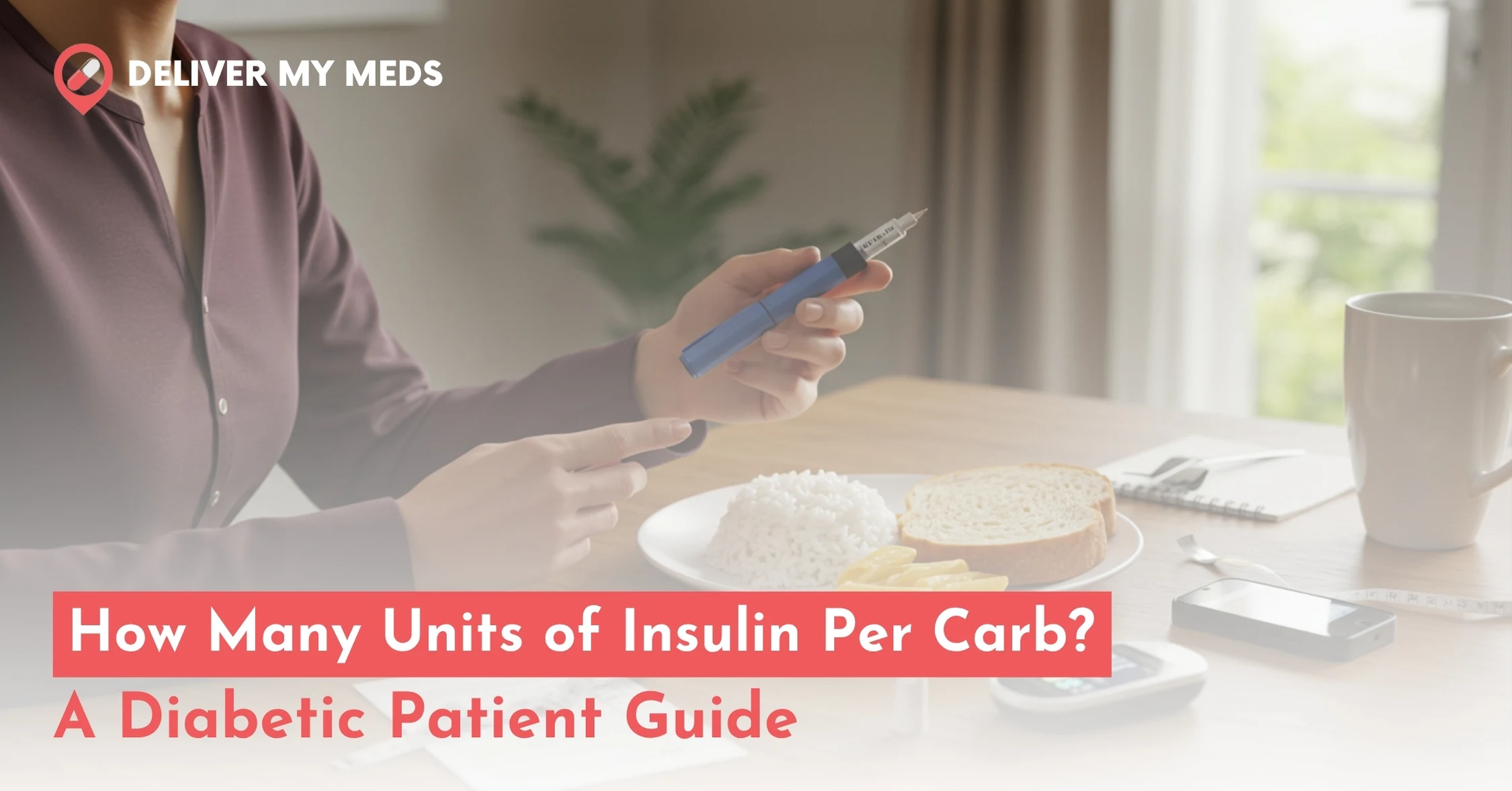
Why Counting Carbohydrates and Insulin Dosing is Important:
Knowing how many units of insulin per carb (carbohydrates) in grams you require is essential to maintaining stable blood glucose levels. For diabetic individuals, especially those who use insulin pumps, getting the dosage right prevents sharp increases or decreases in levels. ICR determines the total insulin dose required based on the number of carbohydrates consumed. If the ICR value is off-target, unpredictable glucose spikes or dips may occur during meal times, potentially leading to serious long-term health consequences.
Carb counting isn’t only for advanced users; it’s the basis for safe and effective the basis for safe and effective diabetes self-management. Even a small misstep can lead to a large swing in blood glucose.
What Is the Insulin-to-Carb Ratio (ICR)?
The insulin-to-carb ratio formula determines how many grams of carbohydrate can be covered with one unit of insulin. This ratio informs your mealtime insulin
For example:
- An ICR of 1:15 means one unit of insulin covers fifteen grams of carbs.
- If your meal consists of 45g of carbs, then your dose will be 3 units.
This carb ratio formula varies based on:
- Age (kids may need different ratios than adults)
- Insulin resistance (especially in Type 2 diabetes)
- Daily activity levels and weight
Some patients may have different units of insulin per carb at different times of the day. Breakfast often requires more insulin due to hormones and slower insulin absorption.
The Rule of 500 Defined: Estimation of ICR Simplified
If you’re just starting, the Rule of 500 is a great way to estimate your ICR.
Here’s the ICR formula: ICR = 500 ÷ Total Daily Insulin (TDI)
Example 1:
- A child with Type 1 Diabetes takes 30 units/day
- 500 ÷ 30 = ICR of 1:17 (1 unit covers 17g carbs)
Example 2:
- An adult with insulin-resistant Type 2 Diabetes takes 60 units/day
- 500 ÷ 60 = ICR of 1:8
This method is commonly used by people with Type 1 and insulin-dependent Type 2 diabetes. Your carb ratio formula might need adjusting over time. These are starting points. Your doctor may change your ICR based on the CGM trends and data. You may need to lower the ratio if you’re consistently high after meals or increase it if you’re having frequent lows. DMM provides the CGMs that help you and your care team track those patterns.
How to Calculate Your Mealtime Insulin Dose Using ICR
Using your ICR, you can figure out how much insulin to take for each meal.
Step-by-Step:
- Count how many carbs are in your meal.
- Divide total carbs by your ICR.
Use this formula: Grams of Carbs ÷ ICR = Mealtime Insulin Units
Example:
- Meal: 60g carbs
- ICR: 1:15
- 60 ÷ 15 = 4 units of insulin
Use the chart below to estimate insulin needs based on your ICR. Here’s a quick guide:
| Carbs (g) | ICR 1:10 | ICR 1:15 | ICR 1:20 |
| 30 | 3 units | 2 units | 1.5 units |
| 60 | 6 units | 4 units | 3 units |
| 90 | 9 units | 6 units | 4.5 units |
What Is a Correction Factor (aka Insulin Sensitivity Factor)?
A correction factor or insulin sensitivity factor (ISF) informs you how much one unit of administered insulin will reduce your blood sugar level. This helps you make tweaks when your BG level is elevated before meals.
Formula (Rule of 1800): ISF = 1800 ÷ Total Daily Insulin (TDI)
Example:
- TDI = 45 units
- ISF = 1800 ÷ 45 = 40 mg/dL
This indicates that 1 unit reduces your BG by 40 mg/dL. Here’s a sample insulin sensitivity factor chart for better understanding:
| Weight | Typical ISF |
| Child | 60-100 |
| Teen | 40-60 |
| Adult | 30-50 |
This varies based on insulin resistance, age, and medication use. This helps when your blood sugar is high before a meal. You are allowed to activate a correction dosage in conjunction with the mealtime insulin. Typical correction factors range from 30-60 mg/dL per unit of insulin.
How to Add a Correction Dose to Mealtime Insulin
Let’s say your blood sugar is high before eating. You can calculate a correction dose using this formula: (Current BG – Target BG) ÷ Correction Factor = Extra Insulin Units
Example:
Current BG: 220 mg/dL
Target BG: 120 mg/dL
Correction Factor: 50
(220 – 120) ÷ 50 = 2 extra units
Assume for this example that ICR indicates you should take 4 units for the meal specified above. With a correction dose of 2 units, your total bolus becomes 6 units.
Tips:
- Avoid stacking insulin
- Wait 2 hours before correcting again
- Always track results
When to Adjust Your Insulin-to-Carb Ratio or Correction Factor
Sometimes your ICR or CF will stop working the way it used to. Here’s when to check:
- You’re getting high blood sugars after meals
- You’re having frequent lows
- You’re sick or stressed
- You’re growing (teens)
- Your activity level has changed
Warning Signs:
- High BG evaluation two hours post-meals suggests ICR is insufficient.
- Low BG = ICR too strong
Hormones, illness, and lifestyle can all affect your insulin needs. Don’t guess track patterns.
How Insulin Pumps Automate ICR and Correction Factor
Modern pumps use built-in calculators to adjust your carb ratio, insulin pump settings, and correction factor in real-time.
Benefits:
- No manual math
- Reduces the risk of errors
- Remembers insulin on board (IOB)
Minimed 770G insulin pumps adjust your ICR insulin based on patterns, meals, and trends.
However, you still need to input:
- Meal carb amount
- Current BG
Always check your settings with your care team. While pumps do the math, manual overrides may be needed during illness or irregular activity.
Insulin Dosing Chart: Quick Reference for Common Scenarios
Table 1: ICR-Based Mealtime Doses
| Carbs in a Meal | ICR (1:10) | ICR (1:15) | ICR (1:20) |
| 30g | 3 units | 2 units | 1.5 units |
| 60g | 6 units | 4 units | 3 units |
| 90g | 9 units | 6 units | 4.5 units |
Table 2: Correction Dose Examples by Blood Glucose Level
| BG Level | Target BG | Correction Factor | Extra Units |
| 220 | 120 | 50 | 2 units |
| 180 | 100 | 60 | 1.3 units |
Use this to guide you before each meal or when your BG is high.
Source: intermountainhealthcare.org
Tips for Safe and Successful Dosing
- Don’t round too much. Be accurate.
- Time your dose 10–20 minutes before eating.
- Use CGMs to track your response.
- Don’t adjust ICR or CF without professional help.
DMM supports your diabetes routine with:
- CGM monitors and accessories
- Easy reorder options for insulin pens and supplies
- Reliable shipping of trusted diabetes brands
Conclusion:
Balancing insulin requires work, but utilising the right tools makes it easier. Knowing your insulin-to-carb ratio, applying correction factors, and tracking every dose gives you the power to keep blood sugar control steady. With DMM, you’re never managing it alone. We deliver the tools you need: insulin pens, CGM monitors, and diabetes care supplies right to your doorstep.




